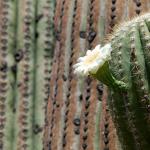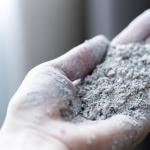It is no coincidence that summer residents came up with a “pseudonym” for gooseberries - northern grapes, thereby hinting at the excellent taste of its berries. Moreover, unlike real grapes, gooseberries are more easy to care for. There is just one disease that he is very afraid of. However, summer residents are also afraid of it, because they often fight it incorrectly.
When I first planted my garden, the first plantings were gooseberry bushes. And I still have a special relationship with them.
By the way, this is the attitude I want to talk about. The thing is that among summer residents this culture is famous for its capriciousness. And therefore, many do not pay attention and are not alarmed when whitish spots appear on the foliage of bushes. So what? He will get well! Now I’ll water it thoroughly and feed it with organic matter, and everything will pass.
Meanwhile, the matter is very serious, because one of the most common and “killer” diseases of gooseberries (and currants, by the way, too) are precisely these whitish spots, i.e. powdery mildew. Everyone knows this name.
But not everyone knows how to fight this scourge and not miss its appearance. For example, there is an opinion that it affects bushes only in rainy and cold weather.
Yes, it affects and develops in such conditions almost at lightning speed. But even in a dry, hot summer, gooseberries are not immune from harm, so while basking in the rays of the sun, summer residents should not relax, looking lovingly at their berry gardens. In hot weather, although powdery mildew develops slowly, it still does its dirty work.
However, inexperienced gardeners can do their plantings a disservice even in warm weather by watering the bushes with cold water, which can also trigger the development of powdery mildew.
If you do not treat the affected shrubs, this will first lead to a sharp decrease in their productivity, and then, after they exhaust their strength in the fight against the disease, to inevitable death. In addition, the causative agents of this infection - spores of a pathogenic fungus - are easily carried by wind and insects throughout the area, which can lead to an epidemic among berry growers in all areas, including neighboring ones.
To combat powdery mildew, you can, of course, use fungicides.
For many summer residents, especially beginners, this is the easiest and most effective way. However, we must remember that the use of such drugs is possible only before or after fruiting. In addition, this is a very strong chemistry, which is still not very appropriate in the garden.
An alternative could be the so-called traditional methods, which have no less powerful effects. Don't know how to use them? Learn. Troublesome?
My first assistant in the fight against powdery mildew is baking soda, or rather, its solution: a glass of 10 liters of warm water. The main thing is not to be lazy and when spraying, try to treat both sides of the foliage of diseased bushes as completely as possible. Horsetail infusion is no less effective in this matter. I fill the bucket a third full with freshly picked plants, fill it halfway with boiling water, cover it with a lid and leave it overnight. In the morning I filter the infusion, bring the volume to 10 liters and spray the plantings.
An excellent remedy against this fungal disease, as well as additional feeding, is ash infusion. To prepare it, pour 1 kg of sifted ash into 3-4 liters of boiling water and leave to steep for three days, stirring the contents periodically. Then I filter the infusion through several layers of gauze and spray the affected bushes.
In order for this or that product to linger better on the leaves and shoots, I add liquid soap to each at the rate of 2-3 tbsp. l. per 10 liters of solution or infusion.
These remedies should be used regularly until the signs of the disease disappear (usually enough maximum of four sprays), And it's better to alternate them. If it rains within 24 hours after treatment, I repeat the procedure as soon as it stops and the bushes dry out a little.
The sweet and sour gooseberry is loved by many gardeners. And how can you do without a single bush on your summer cottage, knowing about the great benefits of gooseberries? After all, it is the richest source of vitamin C.
But when growing this berry in their garden, not everyone manages to get large and beautiful fruits from the harvest due to ignorance of how to protect the bushes from various pests and diseases. One of the most difficult problems for beginning gardeners is the appearance of powdery mildew on gooseberries. This disease is the worst enemy for the plant, which destroys not only the fruits, but also over time kills the viability of the entire bush, even affecting the roots.
Powdery mildew
Powdery mildew on gooseberries is a fungal disease spread by microscopic spores. Gooseberry bushes can become infected through insects that carry spores, or mycelium with spores can get onto the plant bush with the help of wind masses.
Read also the article:! Powdery mildew develops not only on gooseberry bushes, but is also the worst enemy of raspberries, currants, etc. It is not at all difficult to detect affected areas with this disease. Mycelium with spores form a white coating on gooseberry foliage, similar to scattered dry flour.
 Powdery mildew affects not only the leaves of the bush, but also the young shoots of gooseberries.
Powdery mildew affects not only the leaves of the bush, but also the young shoots of gooseberries. 
 If measures are not taken in time, powdery mildew will eventually affect gooseberry fruits.
If measures are not taken in time, powdery mildew will eventually affect gooseberry fruits.
The disease begins its development at the end of May, when the gooseberry forms new shoots and throws out color for the further formation of fruit ovary. Favorable conditions for the reproduction of spores are created by warm weather and a humid atmosphere.
The development of the disease begins from the lower branches of the bush; it is on them that last year’s infecting spores can survive. Many summer residents, not recognizing powdery mildew at the very beginning, are surprised by this picture.  This is what powdery mildew looks like after a few weeks, the light coating becomes rough and changes its color to brown. Such fruits are unsuitable for consumption, since the peel is very difficult to peel off from the berries, especially when they ripen.
This is what powdery mildew looks like after a few weeks, the light coating becomes rough and changes its color to brown. Such fruits are unsuitable for consumption, since the peel is very difficult to peel off from the berries, especially when they ripen.
All affected leaves curl over time, stop growing, and the shoots change their arched shape and dry out. Most of the ovaries fall off, leading to loss of yield. If the plant is not helped, then it simply dies.
How to fight powdery mildew?
Even such complex diseases of fruit bushes as powdery mildew can be prevented and overcome. The fight against powdery mildew involves three approaches.
- Agrotechnical - applicable for minor damage to bushes, when isolated cases of damage are detected.
This method consists of planting gooseberry varieties resistant to powdery mildew and timely pruning of infected branches in autumn or early spring.
Resistant varieties include “Kolobok”, “Harlequin”, “Ural Grapes”, “Grushenka”, “Kuibyshevsky”, “Mashenka”, “Senator”, “Afrikanets”, “Yubileiny”, “Finnish”, “Houghton”.
The cut infected material is burned or buried in the soil in places remote from the gooseberry plantation.
With the onset of the first spring warmth, it is necessary to remove last year's foliage from under the gooseberry bushes, which can also serve as an excellent breeding ground for spores.
Damaged leaves and branches must be removed immediately. Before the buds on the branches of the gooseberry bushes swell, they are treated with a solution of potassium permanganate heated to 90°C; a hot shower disinfects all the branches and the soil under the bush itself (two tablespoons of potassium permanganate are diluted in ten liters of water).
It is worth feeding gooseberry bushes only with potassium and phosphorus fertilizers, which are responsible for the formation of full-fledged strong shoots that can resist powdery mildew, while nitrogen fertilizers, on the contrary, inhibit the development of young shoots, making them more susceptible to this disease.
- Chemical - applicable when large gooseberry plantations are infected and consists of spraying the bushes with potent drugs.
To do this, use copper sulfate (one hundred grams per ten liters of water), the preparations “Topaz”, “HOM”, “Tiovit Jet”, “Vectra”, “Cumulus”.
- Agrochemical - a combination in practice of the above methods for combating powdery mildew.
In the question of how to combat powdery mildew on gooseberries, folk recipes are also valuable, the effectiveness of which has been proven by the practice of many gardeners.
Traditional methods of treating gooseberries for powdery mildew include the following measures:
- preparing a solution for spraying gooseberry bushes from soda and coarsely grated laundry soap (fifty grams of soda and soap per ten liters of water);
- preparing a solution with ash (three kilograms of ash per ten liters of water);
- preparing a solution with urine (one glass of urine per five liters of water).
Spraying of bushes is carried out in the same way as with chemicals, before and after flowering, if necessary, the action is repeated several more times.
Gooseberries without powdery mildew - video
Very often, gooseberry bushes are affected by powdery mildew. The disease has a detrimental effect on the yield and even leads to the death of the bushes. There are many effective ways to combat the disease.
If, when examining the gooseberries, whitish spots are found on the branches and leaves, and brown marks on the berries, it is necessary to take measures to combat powdery mildew.
Powdery mildew: what is it and how does it affect the crop?
In gooseberries affected by powdery mildew, the leaves curl and then dry out. The berries become small and deformed. The disease spreads quickly and leads to the death of the bush. The harvest is dwindling.
When is the best time to carry out treatment?
The fungus produces spores 2 times a year, so gooseberries are processed 3 times a year. During the flowering period, growing season and before dropping leaves. The bushes and the ground under them are cultivated in the evening. Processing should be plentiful.
Important: plants are irrigated with a sprayer. Before carrying out the work, the bushes are cleared of infected foliage and diseased parts, and all litter on the ground is collected, since spores could have overwintered in it.
Strong shoots have good immunity to fungal diseases. To strengthen the protective functions of gooseberries, potassium and phosphorus fertilizers are used. Nitrogen fertilizing has a detrimental effect on the growth of shoots, making them defenseless against fungal disease. In case of extensive contamination of crops on a site, potent chemical agents against powdery mildew are used. 
Folk ways to combat powdery mildew
At the initial stage of damage, gooseberries require immediate help. Before carrying out work, the bushes should be prepared.
- Diseased shoots are pruned, all infected foliage, which has begun to deform and become covered with plaque, is torn off.
- When watering the plant, do not allow water to fall on the leaves, as the moisture spreads spores. In wet weather, watering is reduced, and on hot days it is more frequent.
- Before spraying the bushes, it is recommended to remove the top layer of soil - there is an accumulation of powdery mildew spores in it. You don’t have to remove the soil, but treat it with ash or mustard.
The early stage of fungal infection can be eliminated with folk remedies.
Saltpeter
To combat powdery mildew, ammonium nitrate is used. One foliar feeding is enough and the fungus dies. Treatment is carried out after flowering. Preparation of the solution: 50 nitrate per 10 liter bucket of water. 
Aspirin and baking soda
Preparation of a protective solution: liquid soap (1 tsp), aspirin (1 tablet), soda (1 tbsp), sunflower oil (1 tbsp). The components are dissolved in 4.5 liters of water. Treatment is carried out once, 2 times a month throughout the season.
How to remove white plaque on gooseberries using ash
To prepare the ash solution, take 10 liters of boiling water and 3.5 kg of ash. The composition is left for 24 hours, it needs to be stirred periodically. An ash solution is used to spray gooseberries from late May to early June three times every other day. Water is added to the sediment remaining at the bottom, and the resulting solution is used to treat the soil under the bush.
Whey, kefir, skim milk, milk
Dairy products are an effective remedy for fungal diseases on agrus. The protective composition is prepared from 9.5 liters of water and 1000 ml of dairy product. Treatment is carried out 3 times, after each spraying a three-day break is taken. 
Horsetail decoction
Add 1 kg of field horsetail (fresh) to a 10-liter bucket of water, boil for 2 hours, filter, dilute 1 to 5. Spraying is carried out every week throughout the season.
Potassium permanganate solution
To prepare a medicinal solution of manganese, you need to make rose water: manganese is diluted in a bucket of water. The plant is sprayed once; for preventive purposes, the treatment can be repeated after 6 days.
Infusion of mullein or rotted hay
Rotted hay or mullein is diluted with water in a consistency of 1 to 3. The composition is kept for 3 days and filtered. Spraying is carried out three times (before and after flowering, and before leaf fall).
Onion peel
Add 200 g of onion peels to a 10 liter container of water, boil the infusion, leave for 48 hours, filter. The composition is used in 3 treatments (before and after flowering, before leaf fall). 
Chemical methods for controlling powdery mildew on gooseberries
Fungicidal agents effectively control powdery mildew. The action is due to the penetration of the active components of fungicides into the plant cells; due to the effect of the medicinal composition, the death of the fungus occurs.
Important: the number of gooseberry treatments per season depends on the choice of fungicidal drug. Spraying is carried out according to the instructions.
Copper sulfate
Add copper sulfate (5 g) to a glass of water. In a 5 liter bucket of hot water, dilute liquid soap (50 ml), add a glass of solution with copper sulfate. The composition is stirred all the time. Plants are sprayed once; if necessary, the procedure is repeated every other week. 
Topaz
Fungicidal systemic remedy for fungal diseases of gooseberries. Preparation: 1 ampoule of Topaz is diluted in a bucket of water (10 l). The plant is sprayed with the prepared composition; re-treatment is provided after 14 days.
Bordeaux liquid
The name Bordeaux mixture refers to a mixture of copper sulfate and lime. Before budding and after flowering, I treat the gooseberries with a 3% solution of the mixture. The cooking method is indicated on the package.
Colloidal sulfur
A solution of colloidal sulfur copes not only with powdery mildew, but also with mites. For spraying, prepare a solution of 35 g of the product diluted in a container of water (10 l), the work is carried out in the spring.
Biofungicides: how to cure gooseberries using biological preparations
Biological additives are used to protect gooseberry bushes from diseases and garden pests. The products are safe for people and vegetation. The drugs are made from bacteria. 
Fitosporin
The product is used for preventive and therapeutic measures in plants in the spring. To prepare a protective composition for a ten-liter container of water, 130 ml of a biological preparation is required.
Fitoverm
Biological insecticidal agent is intended to destroy aphids, mites, and pathogens.
Prevention: is it possible to prevent white plaque?
It is easier to prevent diseases than to fight them later. Therefore, it is necessary to take antifungal measures for gooseberry bushes.

If you start preventive measures before the plant wakes up, then in spring and summer you will not have to deal with fungal diseases.
Precautionary measures
You should work in protective clothing and gloves. If plants are sprayed with chemical compounds, in order to avoid inhalation of vapors, work is carried out in a respirator. Solutions are prepared in calm, calm weather without wind. When preparing formulations, the recommended dosage should be taken into account; no need to exceed the norm. When spraying, smoking, eating, and drinking are prohibited. Children and pets should not be present near the place of work.
After spraying, you should take a shower and wash. Gloves are disposed of, work clothes are washed. The remaining preparation, as well as the working solution, should be stored in a place protected from eyes. Timely prevention of powdery mildew will allow gooseberries to produce an abundant, healthy harvest of berries.
How to prevent the development of the disease?
And of course, we must not forget about prevention.
- It is imperative to prune bushes in autumn or spring, and remove infected shoots and burn them outside the site.
- Inspect the bushes in spring and summer for the presence of infected shoots and leaves and, if found, remove them immediately.
- Before winter and early spring, carefully collect leaf litter under bushes, since powdery mildew spores can safely survive the winter in fallen leaves.
- In the spring, before the buds begin to swell, pour boiling water over the bushes - this is an excellent prevention of not only powdery mildew, but also other fungal diseases.
- It is advisable to fertilize the crop with potassium and phosphorus fertilizers and try to refrain from using nitrogen fertilizers, since the former increase resistance to powdery mildew, and the latter often do not allow the shoots to fully ripen, which leads to severe damage by this disease.
It is advisable to combine preventive measures and apply them comprehensively. Have a good harvest!
Spheroteca, or simply powdery mildew, appears in all its glory on gooseberry bushes in June. A white coating, similar to moss, covers the berries, leaves, shoots, mostly young ones. The disease can not only deprive a summer resident of his harvest, but also completely destroy the bushes. How to treat gooseberries against powdery mildew in the spring, what products give the greatest effect - these questions concern gardeners, experienced and beginners.
What kind of “chemistry” should I spray gooseberries with?
A fungus that overwinters well in the root zone, the causative agent of powdery mildew, awakens in the spring and quickly sheds spores, infecting neighboring plants and soil. Although the disease comes into full bloom at the beginning of summer, all preventive measures are carried out in the spring, as soon as the snow melts.
If powdery mildew was noticed on the site last season, in the first days of spring they must take measures to curb the spread of spheroteca and carry out preventive treatment of gooseberries. Experienced gardeners can notice signs of damage even before the buds open.

The following drugs are popular among summer residents in the fight against fungus.
- "Nitrophen". Spraying is carried out strictly until the buds open. For treatment, 200 g of the drug is diluted in 10 liters of water.
- “Topaz” - a solution for spraying is prepared by diluting the contents of 1 ampoule of the product with 10 liters of water. Plants are treated 2-3 times before flowering with an interval of 2 weeks. The drug is moderately toxic to people and pets. It is not used near bodies of water.
- "Tilt CE" - suitable for the prevention and treatment of already diseased bushes. It has the ability to penetrate the cells of the surface tissues of plants, which increases its duration of action. The emulsion for spraying is prepared at the rate of 0.4 ml of product per liter of water. The result is obvious within a couple of hours after use. The drug is not used if there is an apiary or fish ponds nearby.
Also used for treatment and prevention are “Emistar Extra”, “Vitaros”, “Skor”.
You can treat gooseberries before the buds open using proven means:
- copper sulfate – 80 g/10 l of water;
- iron sulfate – 30 g/10 l of water;
- ammonium nitrate – 50 g/10 l;
- potassium permanganate – 1.5 g/10 l of water.
Simultaneously with the treatment of the shrubs, the products are sprayed onto the ground.
At the stage of bud formation, it is effective to use copper oxychloride, dissolving 30 g of the drug in 10 liters of water.
To prevent or treat powdery mildew on gooseberry bushes, do not use colloidal sulfur, since it causes loss of leaves in the plant.
Chemical preparations of the same name are not used for more than 2 years in a row, since the mycelium can adapt to unfavorable conditions.

Biofungicides
Gooseberry bushes are sprayed with biofungicides when daytime temperatures rise above 15°C. They can be used at all stages of the growing season. Planriz, Fitosporin-M, Pseudobacterin-2, and Trichodermin work effectively against powdery mildew.
Excess nitrogen in fertilizing increases the sensitivity of gooseberries to the pathogen.

Folk remedies for fighting spheroteca
The use of folk remedies in the prevention of disease is no less effective than the use of chemical or biological drugs. But the old recipes that came from the people are completely safe for people, birds, pollinating insects and other inhabitants of the garden plot.
The peculiarity of using folk remedies on gooseberries is that the bushes are not sprayed, but each shoot is generously moistened.
- Watering with boiling water
The procedure is carried out as soon as the snow melts. All debris is first removed from under the bushes. Exposure to temperatures above 60°C is detrimental to spheroteca spores; very often such a simple procedure is enough to completely get rid of the causative agent of the disease.
- Wood ash
Ash is a good remedy against a number of gooseberry pests (moths, aphids, sawflies, snails, slugs). At the same time, it serves as a supplier of calcium, potassium, phosphorus, and reduces soil acidity.
For spring processing, take dry ash and sift it. Dusting of bushes is carried out at the rate of 15-20 g per bush. At the same time, the ash is poured into the soil under the root (300 g/m2) when digging, spilled with water, and dry soil is sprinkled on top.
During the spring, four or five more treatments of gooseberries with ash are carried out, but in liquid form. The infusion, prepared at the rate of 300 g of ash per liter of water, is kept for 5 days, then the bush is generously sprayed.
- Soda Ash
Before flowering begins and immediately after its completion, gooseberry bushes are treated with a soda solution. First, dilute 50 g of the product in boiling water, then add water to a volume of 10 liters, add 1 tbsp. l. liquid detergent.
- Soda with aspirin
Prepare a solution for spraying from 1 tbsp. l. soda, 1 aspirin tablet, 1 tsp. liquid soap, 1 tbsp. l. any vegetable oil, 4.5 liters of warm water. Treatment of gooseberries begins from the moment the buds open and is repeated every 2 weeks.
Brilliant, common in a home medicine cabinet, also helps get rid of fungus. Add 2 drops of antiseptic to a bucket of water and spray the gooseberries.
- Mullein
The solution for treatment is prepared as follows: 1 part of rotted manure is diluted with 3 parts of water, left for 3 days, filtered, and 3 parts of water are added to 1 part of the infusion. The product is suitable for treating plants before and immediately after flowering. Rotted hay or straw is used in the same way.
- Whey, kefir or sour milk
A liter of dairy product is diluted with 9 liters of water. Spray on young leaves three times a week. To increase the effectiveness of the solution, add 10-15 drops of iodine to it.
- Onion peel
200 g of raw materials are boiled for 10 minutes in 10 liters of water, allowed to brew for 2 days, filtered, and the husks are squeezed into an infusion. Treatment is carried out before flowering begins and after it ends.
- Tansy
Dry leaves and flowers (300 g) are poured with cold water (10 l) and left for 2 days. Simmer over low heat for 3 hours, filter. The resulting solution is sprinkled on the ground under the bushes after spring digging.
- Horsetail
100 g of dry herb is soaked in 10 liters of water, after a day of infusion, it is boiled over low heat for an hour. The cooled broth is diluted with water 1:5. Horsetail is used to treat gooseberries from early spring until the end of leaf fall.
Spraying gooseberries with fertilizers immediately after the end of flowering performs two functions simultaneously: it feeds the bush leaf by leaf and prevents infection with powdery mildew. A solution is prepared from 20 g of superphosphate, 50 g of potassium chloride, 30 g of urea, 5 g of potassium permanganate, 10 l of water.

How to properly treat gooseberries against powdery mildew?
The first treatment of gooseberry bushes is carried out strictly until the buds open. To do this, select a chemical fungicide or folk remedy, including watering with hot water. The timing of the second treatment is the beginning of flowering, the optimal use of biological products or products prepared according to folk recipes. The third spraying is after flowering is completed. Use biofungicides or traditional methods.
Shrubs are processed in the following order:
- To carry out the procedure, choose a dry, cloudy, windless day or the early evening hours of a sunny day.
- Carefully spray the crown, making sure that the product is sprayed on both sides of each leaf - top and bottom.
- The side parts and base of the bush are treated in the same way.
- Water the soil under and around the gooseberries with the medicinal solution.
It is advisable to simultaneously treat plants and soil in nearby beds.

Agrotechnical techniques
It is difficult to achieve a sustainable positive result by treating shrubs alone. It is also important to follow the simplest agrotechnical rules:
- thinning the bush, timely cutting out old branches that produce few berries;
- maintaining cleanliness under the bushes, regularly removing debris;
- refusal of nitrogen fertilizers.
Some gardeners successfully use dry remains of garden and vegetable plants to combat the pathogen of powdery mildew. The trunk circle is covered with tops and watered with a solution of the EM preparation. Beneficial microorganisms happily feed on the spores and mycelium of the spheroteca.
A positive result in curbing the spread of spheroteca spores is obtained by sowing doctor plants under the bushes - garlic, marigolds (tagetes), dill, parsley, etc. The first two also protect plants from pests, and herbs attract beneficial insects.
Protecting gooseberries from powdery mildew is a constant process; the lightest spores are regularly carried by the wind. Spring treatment of bushes protects berry bushes from pathogens introduced in the fall. In order to fully protect the garden from the sphere library, you need to constantly monitor the condition of the bushes, prevent them from shading or thickening, spray them with an optimally selected composition in due time, and cut out shoots with signs of damage with a firm hand. Compliance with the entire set of measures will preserve the harvest of gooseberries and the health of all plants on the site.

















